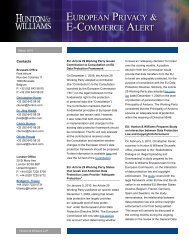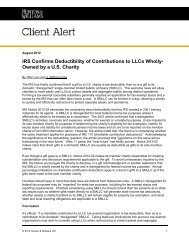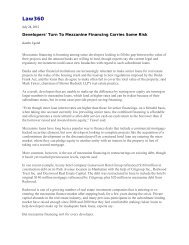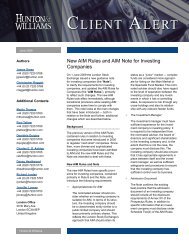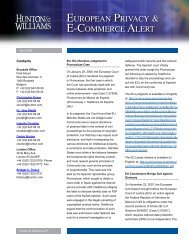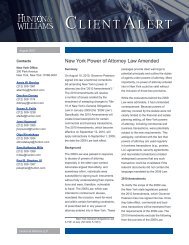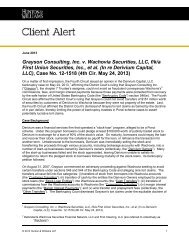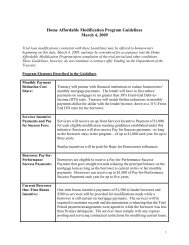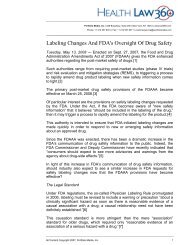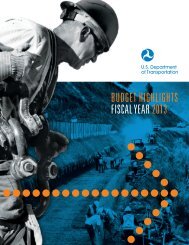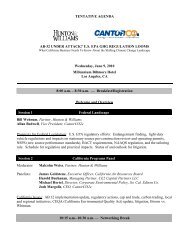Hunton & Williams Renewable Energy Quarterly, September 2009
Hunton & Williams Renewable Energy Quarterly, September 2009
Hunton & Williams Renewable Energy Quarterly, September 2009
You also want an ePaper? Increase the reach of your titles
YUMPU automatically turns print PDFs into web optimized ePapers that Google loves.
<strong>Renewable</strong> <strong>Energy</strong> <strong>Quarterly</strong><br />
3. Substantial Transformation Test<br />
As stated above, there are two amorphous standards that<br />
are espoused for determining when products that undergo<br />
further manufacturing can be considered a product of<br />
the United States (or a product of a free trade agreement<br />
country). Despite guidance by the EPA, the fact is that these<br />
standards are not predictable. Without predictability, it makes<br />
it extremely difficult for renewable energy companies to know<br />
whether their projects are compliant with the Buy American<br />
rules.<br />
Even Customs has proposed eliminating altogether the<br />
substantial transformation test due to its unpredictability.<br />
Customs has stated the following:<br />
Despite its heritage and apparent straightforwardness,<br />
administration of the substantial transformation<br />
standard has not been without problems. These<br />
problems derive in large part from the inherently<br />
subjective nature of judgments made in case-by-case<br />
adjudications as to what constitutes a new and different<br />
article and whether processing has resulted<br />
in a new name, character, and use. The substantial<br />
transformation standard has evolved over many<br />
years through numerous court decisions and CBP<br />
administrative rulings. Because the rule has been<br />
applied on a case-by-case basis to a wide range of<br />
scenarios and has frequently involved consideration<br />
of multiple criteria, the substantial transformation<br />
standard has been difficult for the courts and CBP to<br />
apply consistently and has often resulted in a lack of<br />
predictability and certainty for both CBP and the trade<br />
community.<br />
Instead, Customs has proposed a change in tariff classification<br />
system (tariff shifts) for determining whether a change<br />
in origin has occurred. Under this codified method, the substantial<br />
transformation that an imported good must undergo<br />
in order to be deemed a good of the country where the<br />
change occurred is usually expressed in terms of a specified<br />
tariff shift as a result of further processing. This system currently<br />
is in place for making origin determinations for goods<br />
imported from Canada and Mexico pursuant to the North<br />
American Free Trade Agreement.<br />
Due to its predictability, in any final guidance, the FAR<br />
Council and OMB should adopt the change in tariff<br />
classification system for determining origin for Buy American<br />
purposes.<br />
4. Guidance<br />
Another issue for the renewable energy industry is the lack<br />
of transparency with regard to procedures for having Buy<br />
American coverage issues resolved. Although OMB and<br />
the FAR Council issued the guidance on the Buy American<br />
provisions, given the overarching issues, there is no central<br />
authority to uniformly decide Buy American issues. Rather,<br />
typically it is the contracting officer that in the first place<br />
makes decisions concerning the Buy American provisions.<br />
The problem with this type of system is that many decisions<br />
are made without significant oversight and uniformity. There<br />
should be transparent and uniform rules concerning issues<br />
involving the Buy American rules that are issued by a lead<br />
agency like OMB. Unfortunately, however, no such hierarchy<br />
exists. This further stymies businesses because of the lack<br />
of predictability.<br />
IV. Conclusion<br />
Given the ambiguities in the guidance and rules, coupled<br />
with the significant potential penalties for non-compliance, it<br />
is critical that renewable energy companies be aware of how<br />
the Buy American provisions apply and seek legal counsel to<br />
address those areas that it believes are unclear.<br />
Addendum<br />
In early summer, both the FAR Council and the OMB<br />
accepted comments on their interim guidance and rules.<br />
Many comments were received. Both the FAR Council and<br />
OMB intend to issue final rules in early fall. As of the submission<br />
of this article, the final guidance rules have not yet been<br />
released.<br />
25 <strong>Renewable</strong> <strong>Energy</strong> <strong>Quarterly</strong> www.hunton.com



